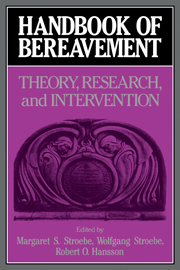Book contents
- Frontmatter
- Contents
- Contributors
- Preface
- Part I Introduction
- Part II The phenomenology and measurement of grief
- 2 The course of normal grief
- 3 Pathological grief reactions
- 4 Measurement issues in bereavement
- Part III Current theories of grief, mourning, and bereavement
- Part IV Physiological changes following bereavement
- Part V The psychological, social, and health impacts of conjugal bereavement
- Part VI Grief reactions to different types of loss
- Part VII Coping, counseling, and therapy
- Part VIII Conclusions
- References
- Author index
- Subject Index
2 - The course of normal grief
Published online by Cambridge University Press: 04 May 2010
- Frontmatter
- Contents
- Contributors
- Preface
- Part I Introduction
- Part II The phenomenology and measurement of grief
- 2 The course of normal grief
- 3 Pathological grief reactions
- 4 Measurement issues in bereavement
- Part III Current theories of grief, mourning, and bereavement
- Part IV Physiological changes following bereavement
- Part V The psychological, social, and health impacts of conjugal bereavement
- Part VI Grief reactions to different types of loss
- Part VII Coping, counseling, and therapy
- Part VIII Conclusions
- References
- Author index
- Subject Index
Summary
Writing an essay on the course of normal grief is more difficult than immediately meets the eye. Grief is a natural phenomenon that occurs after the loss of a loved one. If grief is normal, what, then, is “normal” grief? In our experience, grief is such an individualized process - one that varies from person to person and moment to moment and encompasses simultaneously so many facets of the bereaved's being - that attempts to limit its scope or demarcate its boundaries by arbitrarily defining normal grief are bound to fail. With this in mind, the rest of this chapter should be read not so much as prescriptive of how the normal course of grief should run but, rather, descriptive of the many and varied ways people grieve the death of a significant other.
We begin with a brief review of the stages of grief, its expected duration, and definitions and purported determinants of grief's resolution. Following a discussion of the limitations of the approach, we outline a multidimensional approach to understanding the phenomena and course of grief and supplement the discussion with data from our own work on the multidimensional assessment of widowhood.
The stages of grief
In a similar manner to Kubler-Ross's conceptualization of staging death and dying (1969), many investigators of the process of grief and bereavement have proposed stages of normal grief (Bowlby, 1980/1981; Glick, Weiss, & Parkes, 1974; Pollock, 1987).
- Type
- Chapter
- Information
- Handbook of BereavementTheory, Research, and Intervention, pp. 23 - 43Publisher: Cambridge University PressPrint publication year: 1993
- 173
- Cited by

